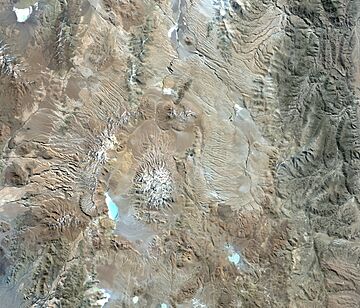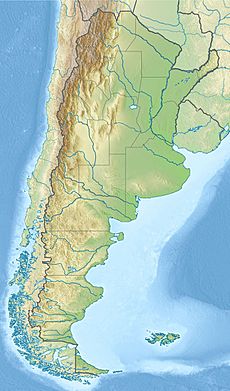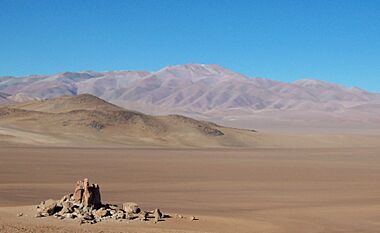Galán facts for kids
Quick facts for kids Galán |
|
|---|---|

Galán viewed from space
|
|
| Highest point | |
| Elevation | 6,100 m (20,000 ft) |
| Geography | |
| Location | Catamarca Province, Argentina |
| Parent range | Andes |
| Geology | |
| Age of rock | 2.08 ± 0.02 million years |
| Mountain type | Caldera |
| Last eruption | Unknown |
Cerro Galán is a giant caldera (a huge bowl-shaped depression formed after a volcano erupts and collapses) located in the Catamarca Province of Argentina. It is one of the biggest exposed calderas on Earth. This amazing natural wonder is part of the Andes mountains' Central Volcanic Zone.
Volcanoes like Galán form because Earth's massive plates are always moving. Here, the Nazca Plate slides under the South American Plate. This movement causes rock deep underground to melt, creating magma. This magma then rises and can lead to powerful volcanic eruptions.
Galán had its first major eruptions between 5.6 and 4.51 million years ago. These events created layers of volcanic rock called ignimbrites. The biggest eruption happened about 2.08 million years ago. It released a massive amount of volcanic material, estimated at 650 cubic kilometers! Today, two hot springs are still active inside the caldera.
Contents
Discovering Cerro Galán: A Giant Volcano
Cerro Galán is in the remote northwestern part of Catamarca Province, Argentina. Scientists first discovered this huge caldera in 1975 using satellite images. It's a challenging place to reach, high up in the Andes mountains.
Long ago, the Inka people used to travel through this area. They even had a resting place, called a tambo, near Laguna Diamante inside the caldera.
Where is Cerro Galán Located?
Galán is part of the Central Volcanic Zone in the Andes. This zone is on the western edge of South America. Here, the Nazca Plate slowly slides under the South America Plate. This process creates many volcanoes.
There are about 50 active volcanoes in this Central Volcanic Zone. Other volcanic belts exist to the north and south. Galán is one of several large caldera systems in this region.
The area around Galán has seen many huge eruptions. These eruptions created vast layers of volcanic rock. Sometimes, the actual openings where lava came out are only visible from space.
Galán sits on the eastern edge of the Andes. This region is known as the Puna, a high plateau similar to the Tibetan plateau in Asia.
How Big is Cerro Galán?
Galán is truly enormous, measuring about 38 by 26 kilometers across. This makes it one of the largest calderas on Earth. Some people even call it a supervolcano.
The lowest part of the caldera floor is around 4,500 meters high. The entire caldera has an oval shape, stretching from north to south. Inside, there's a raised area called a resurgent dome. Its highest point reaches about 6,100 meters.
Scientists believe there's still a large magma reservoir deep beneath Galán. This reservoir is a huge body of partially melted rock.
Inside the Caldera: Unique Features
Laguna Diamante: A Special Lake
In the southwestern part of the caldera, there's a lake called Laguna Diamante. It's about 7 by 3 kilometers in size. This lake is famous among scientists for its extreme conditions.
The water in Laguna Diamante is very salty, about five times saltier than the ocean! It also has high levels of arsenic and strong ultraviolet radiation from the sun. Despite these harsh conditions, tiny living things called microorganisms thrive here.
These microorganisms form colorful mats and provide food for a colony of flamingos. You can also find strange tube-shaped structures called microbialites in the lake.
Hot Springs and Waterways
Several rivers flow within and around the caldera. The Rio Aguas Calientes flows north, and the Rio Leon Muerto flows east. These rivers eventually join others and flow into the Salar del Hombre Muerto salt flat.
Cerro Galán's high peaks catch moisture, helping to feed these rivers. This is special because long-lasting rivers are rare in this dry region.
The caldera also has two main hot springs. One is in the north, and the other is at the base of the resurgent dome. These springs release water that is very hot, between 56 and 85 degrees Celsius.
One hot spring, Aguas Calientes, even has boiling water. Another area, La Colcha, has fumaroles (vents releasing steam and gases) and boiling water that flows into Laguna Diamante. These hot springs show that there is still heat deep underground.
How Cerro Galán Was Built
The ground beneath Galán is made of very old rocks, some as old as 600 million years. These rocks include metamorphic (changed by heat and pressure) and sedimentary (formed from layers of sediment) types.
Volcanic activity in this area began about 14.5 million years ago. Around 7 million years ago, the activity moved closer to where Galán is today. This led to the formation of several volcanoes on its western side.
What is Galán's Magma Made Of?
The melted rock, or magma, that erupted from Galán was rich in potassium. It formed rocks like dacite and rhyolite. These rocks contain minerals such as quartz, biotite, and plagioclase.
Scientists believe Galán's magma formed when hot basaltic magma from deep within the Earth heated and melted existing rocks in the lower crust. This process, along with mixing and cooling, created the unique magma that erupted.
Before a big eruption, magma would gather in chambers about 4 to 8 kilometers deep. New magma rising from below might have triggered these massive eruptions.
Earth's Fiery Past: Eruptions of Galán
Volcanic activity at Galán happened in two main stages. These stages created a large plateau of volcanic rock around the caldera. This plateau covers about 3,500 square kilometers.
Early Volcanic Activity
The first stage of eruptions occurred between 5.60 and 4.51 million years ago. During this time, several large ignimbrites (fast-moving flows of hot gas and volcanic rock) erupted. These are known as the Toconquis Group.
These early eruptions also created lava domes. The ignimbrites from this period covered a huge area, extending up to 80 kilometers from the caldera. Their total volume was about 650 cubic kilometers.
The Giant Galán Eruption
The most massive eruption of Galán happened about 2.08 million years ago. This event created the Galán ignimbrite. This ignimbrite spread out from the caldera for up to 80 kilometers.
The Galán ignimbrite is very thick, especially inside the caldera, where it is at least 1.4 kilometers deep. This eruption was one of the biggest known volcanic events in Earth's history. Such giant eruptions are extremely rare.
The ground collapsed after this huge eruption, forming the main Galán caldera. A lake likely formed inside the caldera after this event.
After the Big Blast
After the main Galán eruption, volcanic activity continued. Lava flows erupted along the edges of the caldera. The resurgent dome inside the caldera also rose by about 2 kilometers.
Smaller ignimbrite eruptions continued for a while, until less than 2 million years ago. These eruptions used up magma left over from the main Galán event.
Scientists still detect a melt zone, or "Cerro Galán Mush Body," under the volcano. This shows that there is still hot, partially melted rock deep below. The volcano also releases about 200 kilograms of carbon dioxide daily, often through its hot springs.
Life Around Galán: Climate and Wildlife
Cerro Galán is located in a very dry area. It receives only about 65 millimeters of rain each year. Frost can happen at any time, even in summer.
Temperatures in the region can range from 8 to 23 degrees Celsius. Most of the rain falls during the summer months.
At very high elevations, you won't find any plants. Between 3,900 and 5,000 meters, the land is covered by high-altitude steppe. This means mostly grasses like Festuca and Stipa grow there.
In lower areas, especially near water, you can find wetlands with their own unique plants. In sheltered spots, you might see birds like ducks and flamingos.
See also
- Cerro Beltrán
- List of volcanoes in Argentina



